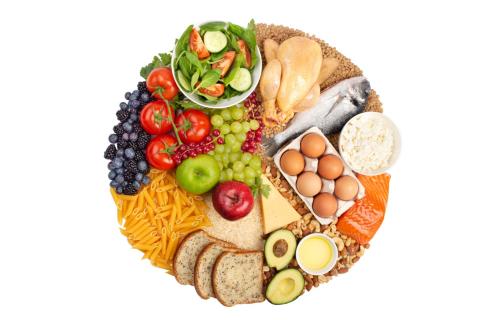The Athlete’s Plate – Eating Balanced
Nutrition with Becca Blumberg – Making your Athlete’s Plate
What we eat in our everyday life has a great impact on everything from our performance to our mood. The food our body needs changes based on many factors, including training volume, frequency, and type. A balanced plate for any individual has several components, however, in this blog, we will focus specifically on what your Athlete’s plate should look like.
The ratio of these foods will change as your training increases. Let’s take a look at what makes up a balanced meal.
Athlete’s Plate for Fruits and non-starchy vegetables
These staples provide plenty of fiber to help you feel full and support heart and gut health. They’re also packed with vitamins and minerals that keep your metabolism and immune system strong and promote the health of your bones and muscles.
When you’re in between training cycles or in the early part of one, you’ll want to fill a full half of your plate with fruits and vegetables. As your training volume increases, the amount of fruits and non-starchy veggies on your plate will go down to 40% to make more room for grains and starchy vegetables.
Remember to “eat the rainbow;” enjoy a wide variety of the not-only-green goodness to get all of the many important nutrients that they provide.
Athlete’s Plate for Carbohydrates
Carbohydrates are found in grains such as corn on the cob, rice, quinoa, and oatmeal and in different kinds of bread, pasta, and starchy veggies such as winter squash and potatoes. They provide energy to fuel your muscles on the run and keep your brain functioning optimally throughout your day. At least half of your grains should be whole (for example brown rice, quinoa, corn, oatmeal, whole wheat bread, pasta, bagels, or tortillas) because these products provide additional protein, iron, and fiber.
Early in training, carbohydrates will fill a quarter of your plate. As training increases, the amount of carbs will increase, too, up to 35%, replacing some of the non-starchy vegetables. This ensures that your body has the energy it needs to perform and recover optimally.
Athlete’s Plate for Protein
Protein is found in meat, eggs, and dairy, as well as many plant products such as beans (like chickpeas, black beans, pinto beans, white beans, and edamame), lentils, soy products (soy milk, tempeh, tofu), and nuts and nut butter. Protein provides the building blocks for recovery from workouts and muscle building, which then allows you to go farther and faster. It also takes a bit longer to digest, so it keeps you satiated for a longer time. This is no small thing; RUNGER is real!
You should focus on lean protein, preferably from a variety of plants. Fish can be included 2-3 times a week. Full-fat dairy and red meat should be limited due to their high saturated fat content. Protein will fill a quarter of your plate throughout training. In the early training stages, it can be a little more (up to 35%) at the expense of carbs if you prefer.
Athlete’s Plate for Fats
Healthy fat is an important part of your diet for its anti-inflammatory properties. It also greatly supports heart and brain health and helps meet the energy demands of higher-volume training. In addition to all that, healthy fat causes the gut to release so-called satiety hormones that let our brain know that we’ve eaten enough; it helps us feel satisfied after a meal or a snack.
Healthy fat comes from plants; think avocado, olive oil, nuts, nut butter, and seeds (chia, hemp, and flax seeds). Early in your training, include 1-3 teaspoons of healthy fat daily. This can increase to 1-2 tablespoons as the training volume increases.
Hydration
We covered hydration in our previous Nutrition with Becca Blumberg article but this can’t be said often enough: don’t forget to drink enough water! Even in winter, you will be losing a lot through evaporation as you breathe. Aim for a MINIMUM of half your body weight in ounces (for example, a 150 lb person should have a goal of 75 oz). Your water intake will increase together with your training volume as well as with heat and humidity.
To count toward your daily hydration, a beverage must have no alcohol or caffeine. While sports drinks may be important during your long runs, they can add a lot of sugar to your diet if you sip on them throughout the day. Plain water is just as hydrating in your day-to-day life.
About Becca Blumberg

Becca (she/her) is a registered dietitian-nutritionist (RDN) based in Fort Collins, CO. She has a Masters in Human Nutrition from Colorado State University and completed a dietetic internship in the Northern Colorado area focused on wellness & lifestyle medicine and is a certified intuitive eating counselor. She’s also a personal trainer and RRCA Level 1 Running Coach. She’s passionate about helping people achieve their endurance goals and seeing the ripple effect that this can create for them.
If you have any questions, are looking for general advice, or just want a nutritionist to have your back, check Becca out at https://www.facebook.com/Ripple.Nutrition or rippleenutrition.wixsite.com/ripplenutrition or reach out to her @ripple.nutrition on Facebook or at beccablumberg@gmail.com.

